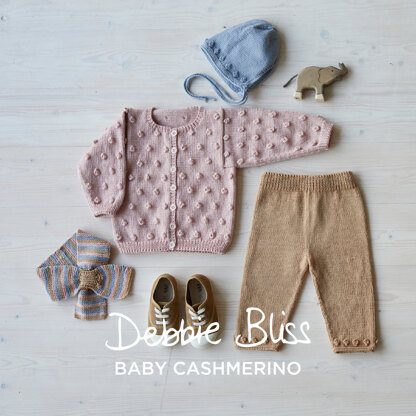4 ways to knit a bobble
Published on May 5, 2021 By Elizabeth Bagwell 3 min readAdd texture to your knitting with a bobble or three or three hundred. Elizabeth Bagwell talks you through the basics, and shows you four ways to make a bobble!
Often described as an advanced technique, making a bobble is actually very straightforward. A bobble is simply a puff of extra stitches abruptly created (e.g. by increasing one stitch to 3 or 5) and then removed. As there are too many stitches to lie flat, the extra stitches pop or puff out, creating a 3D effect. If you do this across lots of stitches, you might get a wave or a gusset, with just a few stitches you get a bobble. This may also be called popcorn stitch or a nupp. You can use pretty much any method of increasing and decreasing to create and remove extra stitches, and there are lots of different ways to go about it.
The Debbie Bliss' Toddlette collection includes a whole layette dedicated to bobbles! The Bobbalicious layette is a sweet set of a beautifully bobbly cardi, leggings and bonnet with bobble detail, and the bobble method in the video above is the one used for this pattern - but - you can increase and decrease extra stitches using this method to make your bobbles larger for different projects if you like!
1. Two row bobble
These are simple little bobbles knit over (you guessed it) two rows. On the first row, increase one stitch to 4, 5, 7 or any number that pleases you. The simplest multiple increase is probably to knit, then purl, then knit (then purl, then knit…) into one.
On the second row, simply purl (or knit, but purl is usually easier) all those stitches together. Voila! A little bobble.
2. Larger one-row bobble
To make a larger, more dramatic bobble, increase as described for the two row bobble, then turn and knit back and forth on just the increased stitches for 2 or 4 rows before immediately decreasing.
Pro tip: after a couple of rows or when you’re finished knitting, give the bobble a poke to make it sit proud on the right side of the work.
3. Increase and decrease more slowly
This is a refinement on the larger one-row bobble described above. If increasing and/or decreasing so dramatically isn’t working well for your yarn, you can spread the increase / decrease over a couple of stitches or rows.
4. Bobble cast on
A picot cast on is effectively a cast on lined with small bobbles, but you can also cast on with larger, fatter bobbles like the ones above. It’s fairly straightforward: cast on a few stitches, knit a bobble as described above, cast on again. The bobble will usually hang down a bit at the edge of the work. The technique seems to have been developed by Heidi of Heidi Bears.
5. Bobble cast off
Again, a picot cast off will create a similar effect. Essentially, you cast off a few stitches, make your bobble, cast off the single remaining stitch from the bobble and repeat.



